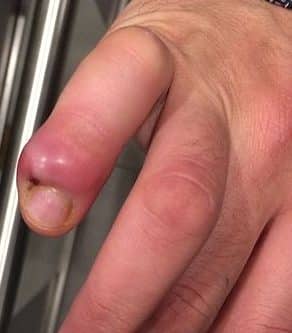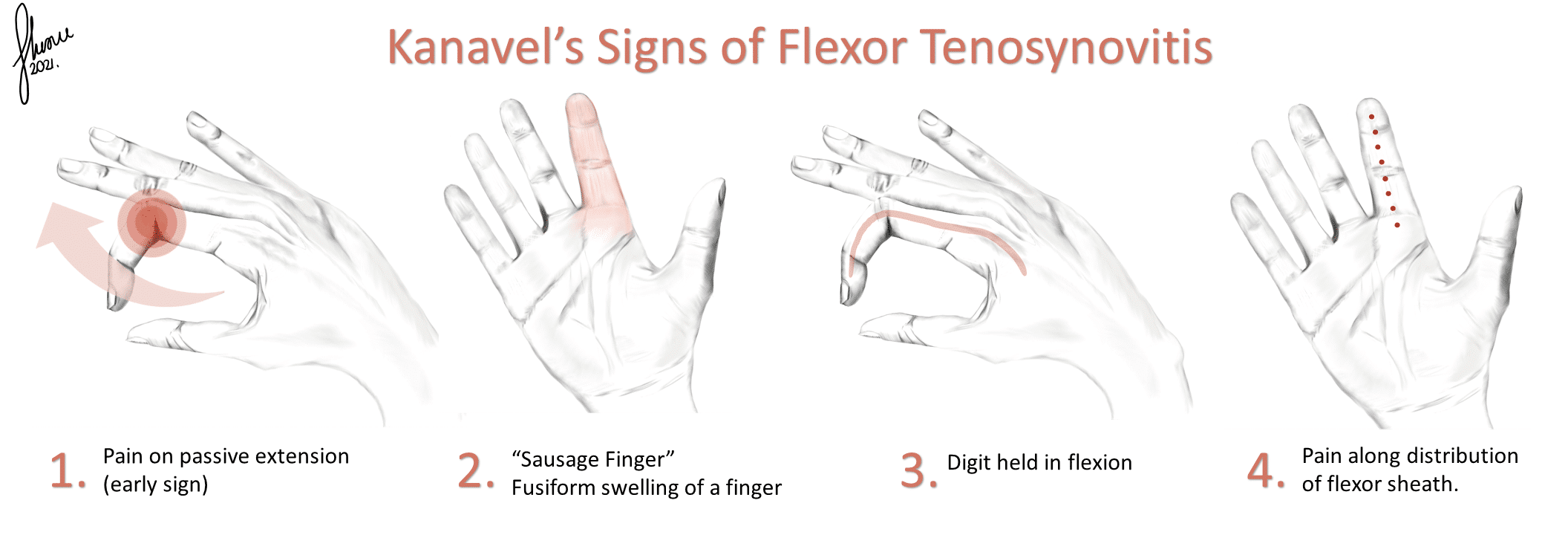Introduction
Hand infections are common presentations to the Emergency Department and often require admission for intravenous antibiotics and surgical intervention.
Hand infections often present as a result of trauma, animal bites, human bites, or contaminated lacerations. Hand infections are more common in those with pre-existing co-morbidities, such as diabetes mellitus, or in current smokers.
The most common organisms are S. aureus or Streptococci. Any hand infection can result in damage to local structures and subsequent loss of function, hence early identification is essential.
This article will focus on common types of infections involving the hand including paronychia, infectious tenosynovitis, felon infections, and deep space infections.
Investigations
Patient presenting with suspected hand infections should have routine blood tests to aid diagnosis, including include CRP, WCC, and urate levels.
As penetrating trauma is often a contributing factor in most hand infections, plain film radiographs are routinely used to exclude foreign bodies and assess for underlying fractures or evidence of osteomyelitis.
For infections producing any pus, wound swabs and / or pus culture can aid appropriate antibiotic selection.
Management
Areas of erythema should be marked to help determine any rate of spread. All hand infections will require antibiotic treatment started, however further management often depends on the type and degree of infection.
Infectious tenosynovitis, flexor sheath infection, and deep space infections will often require a formal thorough washout in theatre, with subsequent re-looks in order to exclude re-accumulation of infection.
Once complete, patients often require a period of close observation and strict hand elevation to reduce swelling.
Paronychia
Paronychia is the most common infection of the hand. Infection of the perionychium (the soft tissue fold around the nail plate) can occur secondary to contamination with oral flora from nail biting or sucking. Previous trauma or injury causing a disruption to the perionychium can be a significant risk factor.
Pus can track along the perionychium in a horse-shoe shape, producing a characteristic abscess at the skin-nail plate junction*. The fingertip may be swollen, inflamed, and very tender (Fig. 2); pus can collect subungually, even cause necrosis of the nail bed and untreated paronychia can result in osteomyelitis of the distal phalanx.
Treatment typically involves antibiotics, however incision and drainage of the pus will be required. Nail plate removal may be necessary to allow for sufficient drainage of pus. Following incision and drainage, a thorough washout with normal saline and antiseptic solution is necessary, with regular dressing changes.
*Chronic paronychia is typically non-suppurative and clinically resembles acute paronychia
Infectious Tenosynovitis
Tenosynovitis is inflammation of tendon sheath, the most common cause of which is infection. Tenosynovitis most often arises from direct inoculation of bacteria (commonly S. aureus) secondary to penetrating trauma*
The most common type of tendosynovitis are flexor sheath infections. These should be deemed as a surgical emergency, as the raised pressure that occurs within the tendon sheath can impair blood flow and lead to eventual tendon necrosis and rupture.
*Haematogenous spread or direct spread from a felon, septic joint or deep space infection can also lead to infectious tenosynovitis

Figure 3 – Illustration showing the anatomy of the flexor sheath of the hand
Patients present with pain, swelling, and erythema of the affected digit. Kanavel’s signs (4 cardinal features, Fig. 4) are strong indicators of flexor sheath infection:
- Tenderness along the flexor sheath
- Flexed finger posture
- Pain on passive extension
- Fusiform swelling of the affected digit
A thorough washout of the flexor sheath in theatre followed by strict elevation and close monitoring should be the mainstay of treatment. It is common practice to perform a re-look and further washout in theatre, especially if the clinical features do not resolve.
Felon Infections
A felon infection is a subcutaneous infection of the fingertip pulp, most commonly occur in the thumb or index finger and are caused by S. aureus.
Fibrous vertical septae run from the periosteum to the epidermis of the pulp, creating a closed system of microcompartments that are susceptible to rising pressure from inflammation.
Felon infections present with swelling of the pulp distal to the distal phalangeal crease and severe pain (Fig. 5). The most common cause is through direct contamination, such as via splinters or garden thorns.
Most cases are simple and will resolve spontaneously after a short period; antibiotics can aid resolution.
Deep Hand Space Infections
The deep spaces of the hand consist of the thenar, mid-palmar, and hypothenar spaces. When infected, the respective spaced become swollen, tender, and erythematous, with hand movements limited.
- The thenar space overlies adductor pollicis and is bound ulnarly by the insertion of the adductor onto the metacarpal; when infected, pus may track dorsally around the adductor and in-between its two heads
- The mid-palmar space is a continuation of the carpal tunnel, deep to the palmar aponeurosis and superficial to the deep palmar interossei; it has multiple septa distally that separate the space and direct the flexor tendons to their digits
- The hypothenar space is located palmar to the fifth metacarpal and dorsal to the hypothenar fascia
Differential Diagnosis
Differentials to consider for a patient presenting with worsening hand swelling and pain include gout* and pseudogout, cellulitis, herpetic whitlow, pyoderma gangrenosum, or retained foreign body.
*Clinically it can be difficult to delineate gout from infection
Complications
Tracking cellulitis and subsequent sepsis is the major concern of hand infections. Early intervention alongside intravenous antibiotics, elevation, and fluids are key to preventing overwhelming infection.
Damage to local structures, including tendons and joints, are of major concern. Patients can develop impaired function of the hand that may take years of rehabilitation to improve.
Overall prognosis is excellent for minor hand infections with most resolving completely within 2-4 weeks. More severe infections also have a reasonable prognosis providing they are identified before infection worsens.
Key Points
- Hand infections are common presentations and often require admission for intravenous antibiotics and surgical intervention
- Common types of infections involving the hand including paronychia, infectious tenosynovitis, felon infections, and deep space infections
- Infectious tenosynovitis, flexor sheath infection, and deep space infections will require intravenous antibiotics and likely a formal thorough washout in theatre




